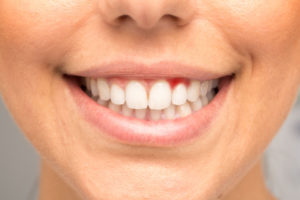
Are you worried about the health of your gums? Gum infections are more common than you may think. According to the Centers for Disease Control and Prevention (CDC), approximately 47% of all adults aged 30 and older have some form of periodontal disease. Depending on the stage to which your gum disease has advanced, your periodontist may be able to completely reverse the symptoms and restore your oral health. However, when you wait too long to address the issue, it can cause permanent damage. Keep reading to learn more about the stages of gum disease in Frisco.
What Is Gum Disease?
Gum disease, also known as periodontal disease, is an inflammation of the gums that can progress to affect the bone that supports teeth. The common condition is most often caused by plaque, a thick film of bacteria that forms on gums and teeth. Common symptoms of gum disease include:
- Persistent bad breath
- Bleeding gums when brushing or flossing
- Sore, swollen or tender gums
- Receding gums
- Sensitive teeth
- Problems biting or chewing due to shifting teeth
- Visible pus surrounding the teeth and gums
The Stages of Gum Disease
If left untreated, gum disease in Frisco progresses through four stages.
Gingivitis
Gingivitis is a mild form of gum disease that results in gum inflammation, redness, and bleeding. It is the only stage of gum disease that is reversible as it has not yet had time to attack the bones. Extra brushing and flossing at home and regular dental checkups can usually treat and reverse gingivitis.
Mild Periodontitis
When gingivitis is left untreated, it can turn into periodontitis. Periodontitis attacks the gum tissue and bone that supports teeth. At this point, the condition is not reversible, but it is manageable through a combination of professional treatment and better gum care at home. Treatment may include scaling and root planing, in which a periodontist removes plaque from above and below the gum line and smooths the surfaces of the affected tooth roots.
Moderate Periodontitis
During moderate periodontitis, deep pockets can form between the tooth and the gum. This allows even more bacteria to attack the gum tissue and underlying bone. Like mild periodontitis, the third stage of gum disease cannot be reversed.
Advanced Periodontitis
In the final stage of gum disease, you may experience bone loss, swollen gums, painful chewing, persistent bad breath, and many more serious health problems. As bacteria destroy the bone that supports your teeth, your teeth may shift or even fall out. Periodontal therapy may be able to halt the progress of the infection but cannot reverse it.
How to Prevent Gum Disease
While gum disease can be cured in the earliest stage, you can also take simple steps to avoid gum disease in the first place. Practicing excellent oral hygiene at home and avoiding tobacco use can help prevent gum infections. In addition, visiting a periodontist in Frisco every six months for a dental exam and professional cleaning is key.
Healthy gums are an essential part of a healthy smile! Talk to your periodontist in Frisco for more preventive tips to avoid gum disease.
About the Author
As a board-certified periodontist, Dr. Zachary Carnow has the skills and knowledge to navigate even the most complex gum disease cases. He has undergone advanced specialty training in periodontics at Tufts University School of Dental Medicine and is an active member of the American Academy of Periodontology. To learn more about gum disease prevention and treatment, visit the Frisco Periodontics and Dental Implants website or call 214-619-4990.
